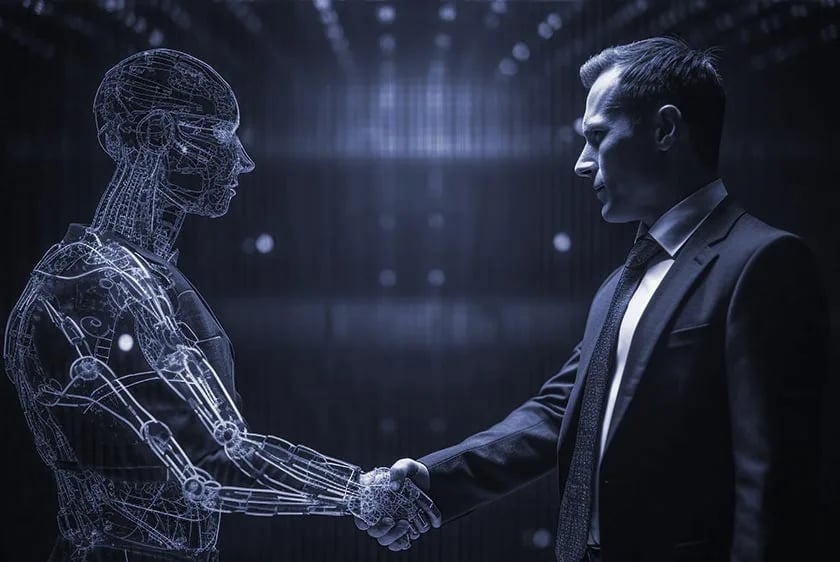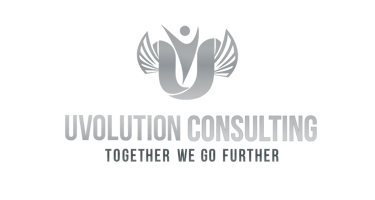The End of ‘High Potential’: Why Everyone Becomes a Leader in the Age of AI
As AI reshapes the foundations of work, leadership is no longer a title, it’s the new baseline. This article explores how intelligent systems are redefining hierarchy, trust, and human value, and why every professional must now think and act like a leader. Discover The Human Edge Framework, the six capabilities that technology cannot automate, and learn how to build lasting relevance in an era where humans and machines lead together.
Omar Berrada
10/22/20258 min read


It’s 2030.
The leadership team of a global company gathers for its annual strategy review. The setting feels familiar, the same boardroom, the same dashboards, yet something essential has changed.
Each department now operates as a hybrid ecosystem of people and intelligent systems. Finance reports are assembled by predictive engines that flag risks before the CFO asks. Operations updates arrive from autonomous agents that reroute supply chains in real time. Marketing briefs are drafted, tested, and refined by AI collaborators that never sleep.
The numbers seem flawless but the conversation doesn’t feel like so.
As the team reviews the results, a subtle discomfort surfaces. The company is outperforming projections, yet no one can clearly explain how. The algorithms did the optimizing; the people approved the outcomes. The organization is thriving but ownership feels diffuse, authorship diluted.
The CEO finally asks, “If intelligent systems now drive most of our results, what does it actually mean to lead?”
The silence that follows can be mistaken for confusion but in reality it is a moment of deep realization. They are still in charge, but leadership no longer looks like it used to.
The illusion of control
This week, reports emerged from internal Amazon documents outlining plans to automate nearly 75% of its U.S. operations, effectively removing or reassigning over 600,000 human roles to machines and robots.
This is a visible expression of a deeper trend that has been accelerating across every major industry.
What this leak reveals is not just the scale of automation that we are moving towards but the structural inversion it represents.
Human contribution is no longer measured by being on-site and repeating work tasks, but by the critical thinking, adaptability, creativity, and direction that machines cannot replicate.
Most executives still picture the future of work as a faster, cleaner version of today: smaller teams, smarter tools, better efficiency. But the deeper shift is structural. Hierarchy, once the spine of how authority and accountability flowed, is dissolving rapidly underneath the surface.
In this environment, every professional, from founder to mid-level specialist, is becoming a node of leadership. Direction, ethical alignment, and decision clarity are no longer confined to titles; they are distributed across the system itself.
The World Economic Forum’s Future of Jobs Report 2025 predicts that 44 percent of core skills will change by 2027, driven largely by AI integration. McKinsey’s State of AI 2024 reports that more than 70 percent of organizations already rely on AI in at least one major business function. The future isn’t approaching, it’s here, rewiring everything in silence, slowly but inevitably, and that includes how leadership is exercised.
The collapse of hierarchy
Traditional structures were built on scarcity. Scarcity of information, context, and decision rights. Managers once acted as interpreters between data and direction. Now, AI systems surface insights faster than any hierarchy can process them. Information has become overabundant, and authority no longer moves downward; it radiates outward.
A single strategist with the right tool stack can replicate what once required an entire department. A financial analyst can model scenarios in minutes that used to take weeks. A designer can run hundreds of creative variations before a meeting even begins. Leadership has shifted from delegation to orchestration.
Deloitte’s Human Capital Trends 2025 calls this “system tension”: the need to balance automation with human initiative, control with empowerment. That tension now defines every level of the enterprise, not just the C-suite.
Leadership, once a structural position, has become a professional language, something everyone must learn to speak to remain credible.
The rise of the unofficial leader
In the coming years, you won’t just oversee people; you’ll oversee the intelligence that supports them. Your department’s results will hinge on how effectively human expertise and machine capability are coordinated.
This is where the idea of “high potential” begins to lose meaning. Organizations can no longer develop leadership capacity in a privileged few. The market evolves too fast, and the consequences of narrow competence are too costly.
Leadership-grade thinking is now the baseline expectation, not because everyone manages people, but because everyone manages impact.
Authority once accumulated through tenure. Now it arrives instantly through access. A thirty-year-old product lead can deploy generative design systems that influence millions of customers overnight. A data analyst can activate AI models that reshape company forecasts in hours.
Leadership in this environment isn’t granted to a few but expected to be exercised by most, often before a title ever appears beside a name. And that shift challenges organizations still built on the assumption that leadership emerges only at the top.
Managing intelligence, not just people
People will always lead people, but they will also lead intelligence. Every leader, regardless of level, must now coordinate humans and machines with equal fluency.
They will need to:
• Assign, monitor, and interpret AI-generated work.
• Safeguard data, privacy, and brand reputation.
• Decide which tasks can be automated and which demand human context.
Research from MIT Sloan’s Responsible AI Initiative notes that governance and oversight of intelligent systems have become essential management disciplines. And Harvard Business School’s Karim Lakhani puts it plainly: “Humans with AI will replace humans without AI.”
Tomorrow’s leaders will not be defined by technical fluency alone but by their ability to integrate technology into decision systems that enhance trust and performance.
Leadership capacity, in this sense, is no longer about authority or headcount. It has become about how individuals manage intelligence, human and non-human, to create value that is both effective and ethical.
The subtle reordering of value
The World Economic Forum projects that analytical thinking, creativity, and leadership-oriented capabilities will see the fastest growth in demand over the next few years. What’s unfolding is not competition between humans and machines, but a redefinition of what human value means within intelligent systems.
And this leads to the question now confronting every executive and ambitious professional alike:
If leadership is no longer a promotion but a prerequisite, which capabilities will determine who thrives?
How will career progression look when every level already demands leadership-grade competence?
These are not hypothetical questions. They are strategic ones and the answers will define both the relevance of individuals and the resilience of organizations in the decade ahead.
The silence that follows that 2030 boardroom moment wasn’t just a realization of change.
It was in fact the recognition that the criteria for relevance have shifted.
When intelligent systems execute most operational work, the differentiator isn’t efficiency but humanity. The future workforce will be defined not by who can use AI, but by who can elevate it.
The new skill hierarchy: The Human Edge for all
The capabilities once reserved for leadership programs are now the foundation of employability. What once made a “high-potential” executive stand out is fast becoming the minimum for staying indispensable.
These six skills form The Human Edge Framework: the enduring capabilities that machines can’t replicate and organizations can’t survive without.
1. Analytical Thinking & Complex Problem Solving
Still the most in-demand capability through 2027 (WEF 2025). The value isn’t in crunching data; but in connecting consequence and context. Asking the right questions before the algorithm answers them.
2. Creativity & Original Thinking
Generative tools reproduce form, not intent. Creativity now means reframing problems, challenging assumptions, and designing value where the system sees only patterns.
3. Emotional Intelligence
In a digital workplace, trust becomes the human currency. Emotional intelligence allows leaders to sense tone, intention, and culture which are the subtleties no model can learn.
4. Influence, Presence & Mentorship
Authority no longer compels, credibility does. Influence aligns distributed teams, mentors nurture adaptability, and presence sustains coherence across hybrid systems.
5. Adaptability & Self-Learning
The half-life of skills keeps shrinking. Very recent studies by Deloitte shows that organizations thriving amid automation are those where learning is continuous and self-directed. Adaptability is now a deliberate strategy.
6. Ethical Judgment & Systems Thinking
Every intelligent tool creates second-order effects. Leaders who weigh efficiency against consequence define the moral intelligence of their organizations. MIT Sloan’s Responsible AI research calls this “operationalized ethics.”
Together, these six capabilities form the human infrastructure that allows technology to scale safely and intelligently. We are not talking about soft skills here, we are defining sovereign skills: the foundation of modern leadership.
Democratizing leadership
If every employee orchestrates human + AI workflows, leadership can’t remain a managerial privilege. It must become a shared organizational capability.
The old funnel: identify, train, and promote, is too slow for a market evolving faster than titles. Deloitte’s Global Human Capital Trends 2025 found that companies treating leadership as a collective behavior outperform those treating it as a career stage.
Embedding leadership education into the flow of work such as ethical-AI modules, scenario simulations, and peer-learning circles, creates what I call Leadership Density: the percentage of people who can act with leadership-level autonomy when it matters most.
High-density organizations adapt faster, execute smarter, and make fewer integrity errors because direction doesn’t depend on hierarchy. Everyone becomes an active contributor to progress, not just a follower of it.
The rise of the Hybrid Operator
The next generation of top performers won’t be “managers” or “individual contributors.” They’ll be Hybrid Operators: fluent in both human collaboration and intelligent orchestration.
They will:
• Design workflows where humans and machines complement each other.
• Translate strategic intent into machine-readable action.
• Protect ethics, security, and brand integrity while driving performance.
MIT CISR projects that by 2027 roughly three-quarters of employees will collaborate directly with generative AI in some form. The professionals who excel will think both technically and contextually, combining precision with empathy.
Hybrid Operators aren’t outliers; they’re the blueprint of relevance.
The Human Edge as the bridge to relevance
Every executive senses the widening gap between technological acceleration and human adaptation. Systems evolve in months; people, in years. That gap is where professional obsolescence begins.
The Human Edge Framework exists to close it.
We are beyond theory and in the midst of a practical system that helps ambitious professionals and organizations build the six human capabilities that technology cannot automate: Analytical Thinking, Creativity, Emotional Intelligence, Influence, Adaptability, and Ethical Judgment.
The same skills that once defined high-potential leaders now define enduring relevance.
If you’ve ever wondered what separates those who thrive in the age of AI from those who merely adapt, this is it.
The Human Edge is anything but a competition with machines; but all about learning to lead intelligently alongside them.
While researching this topic for myself, and to help my clients navigate the uncertainty that AI was creating in their teams and industries, I realized that what I was uncovering was too important to keep within a small circle.
The insights and frameworks emerging from that research deserved to be shared more widely not as theory, but as a contribution to this pivotal phase in the evolution of how humans create, lead, and work alongside intelligence.
That work became my book, “How to Stay Relevant When AI Is Changing Everything”.
It’s a free guide written for ambitious professionals and business leaders who refuse to be paralyzed by the speed of change, and who want to transform uncertainty into capability, fear into relevance, and disruption into progress.
You can download it HERE
Because the future of leadership will not be inherited, it will be learned, and then earned.
Cultural repercussions? Rethinking hierarchy, trust, and status
When everyone is expected to think and act like a leader, the social architecture of organizations begins to shift in profound ways.
I invite you to reflect on this and to join the conversation. Whether on public forums like LinkedIn or directly within your organization, these are the questions that will define how we build the next era of intelligent work:
What happens to hierarchy when leadership becomes universal?
How does trust evolve when authority is distributed instead of assigned?
What signals status in a workplace where empathy, adaptability, and ethics not titles define influence?
Here we are not speaking of some abstract reflections. These are urgent strategic questions for every leader, executive team, and ambitious professional navigating what comes next.
The organizations that explore them early will shape the cultural standards of the intelligent enterprise, and they will be remembered not for how fast they adopted AI, but for how maturely they integrated humanity into it.
If these questions resonate with you, I would welcome the dialogue.
Let’s explore together what responsible, human-centered progress can look like in an age defined by intelligence.
Thank you for reading and until next time, stay focused and irreplaceable my friends.


Sources and References
World Economic Forum, Future of Jobs Report 2025
McKinsey & Company, State of AI 2024
Deloitte, Global Human Capital Trends 2025
OECD, Skills Outlook 2023
LinkedIn Learning, Workplace Learning Report 2024
MIT Sloan Management Review, Responsible AI
Harvard Business School, Karim Lakhani on AI Leadership


